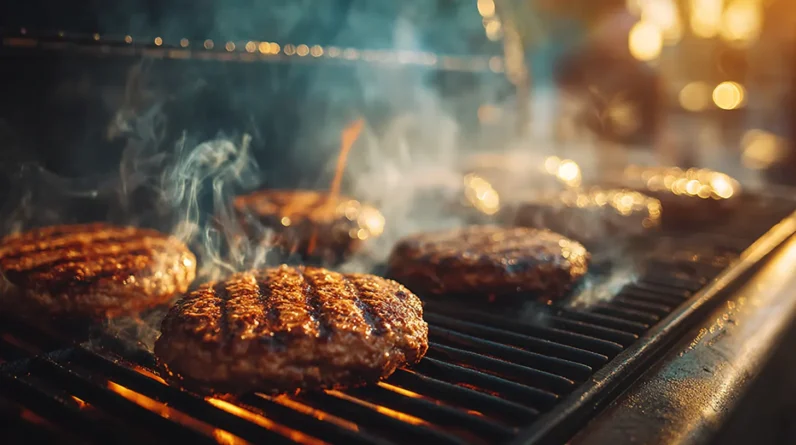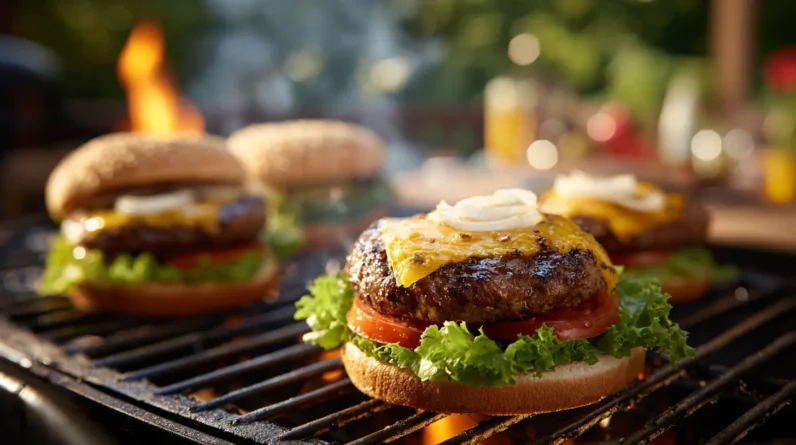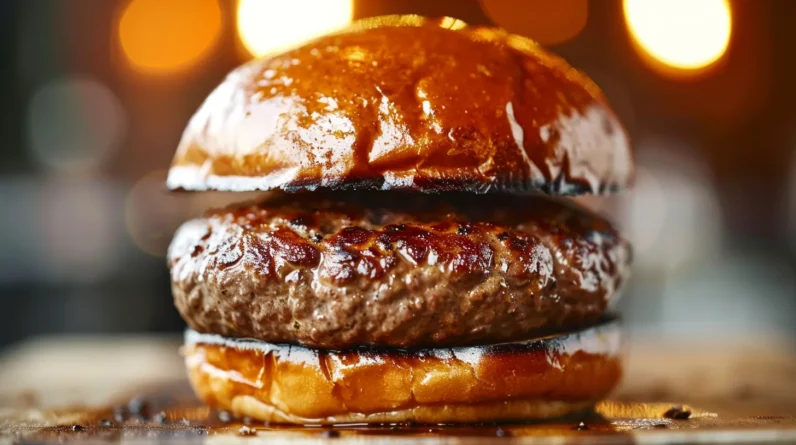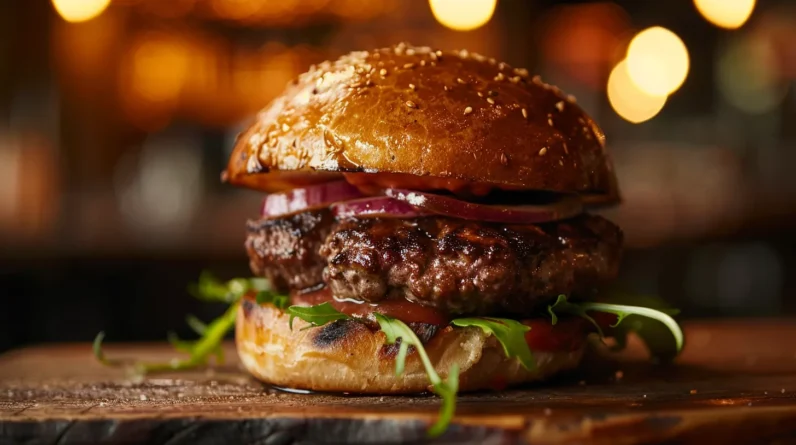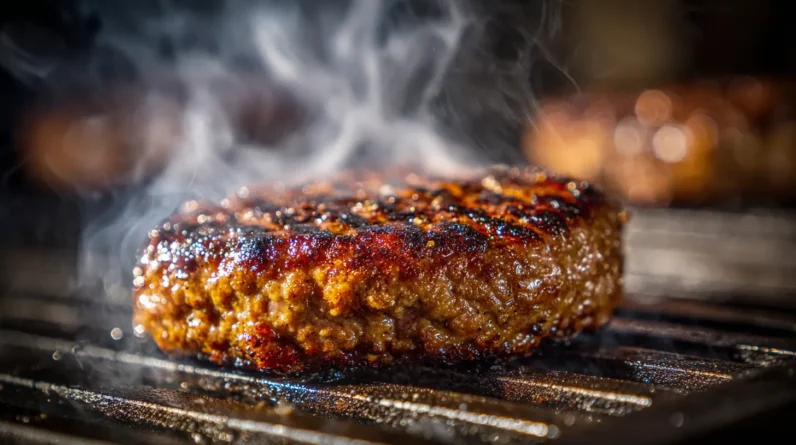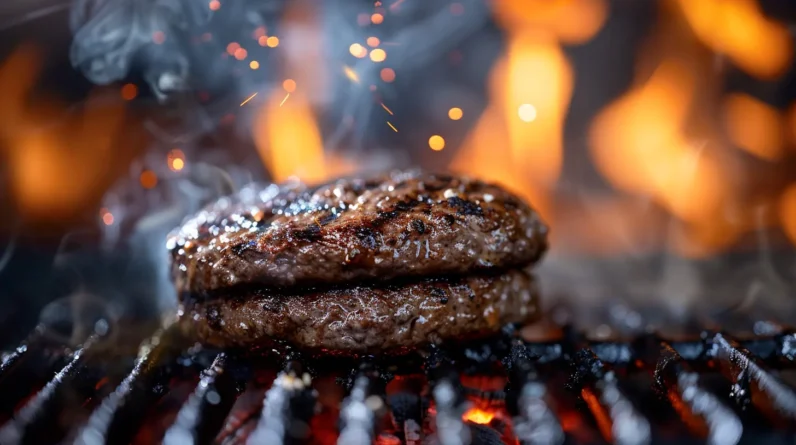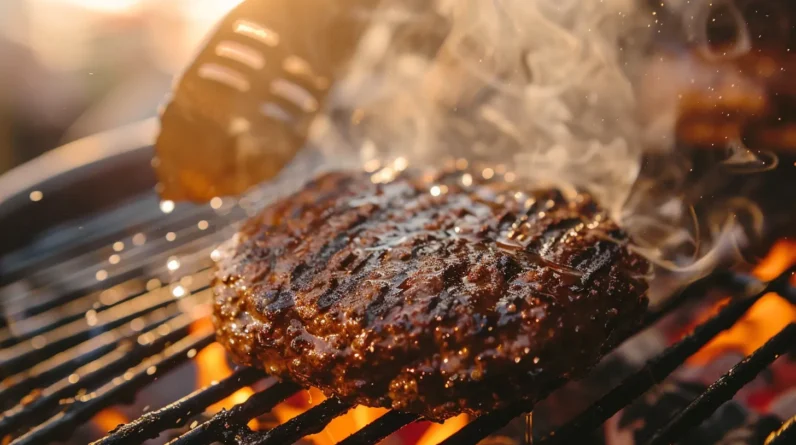
We’ve found the difference between legendary burgers and mediocre ones lies in mastering counterintuitive techniques: create a thumb-sized dimple in your patty’s center to prevent doming, establish dual heat zones at 450-650°F for searing and 225-350°F for finishing, and flip multiple times every 60-90 seconds instead of just once. This approach reduces cooking time by 29% while distributing heat evenly throughout the patty. Master these fundamentals and you’ll discover why precision matters more than tradition when transforming ground beef into something extraordinary.
Master the Perfect Patty Formation Before It Hits the Grill
The foundation of an exceptional grilled burger starts with proper patty formation, not grill technique. We’ll work with cold 80/20 ground beef, handling it minimally to prevent toughness. Form balls first, then gently press to 3/4″ at edges and 1/2″ in center—this differential thickness guarantees even cooking. Create a thumb-sized dimple in each patty’s center to counteract doming during grilling.
Critical: Don’t salt before forming. Early salting dissolves proteins, creating a dense, sausage-like texture. Season only just before grilling. Avoid over-compressing the meat; we’re building cohesion without sacrificing tenderness. Refrigerate formed patties for one hour minimum. This step firms the fat, helping patties maintain shape under heat. Proper meat handling here determines whether you’re serving restaurant-quality burgers or disappointing pucks.
Dial In Your Grill Temperature and Heat Zones Like a Pro
Temperature precision separates amateur grillers from pit masters. We’re establishing two distinct heat zones on our grill: a searing zone at 450-650°F for direct heat, and a finishing zone at 225-350°F for indirect heat. This dual-zone setup gives us complete control over the cooking process.
For gas grills, we’ll crank burners to high on one side while leaving the other off. Charcoal users should pile coals exclusively on one side. We’re targeting 400°F grill temperature in our direct zone for ideal burger searing.
Place thermometers in both zones—guessing temperatures guarantees inconsistent results. We’ll sear burgers over direct heat until they develop a proper crust, then move them to indirect heat until they reach 160°F internally. This method prevents burnt exteriors and raw centers.
The Science of Timing and Flipping for Maximum Juiciness
While conventional wisdom insists we flip our burgers only once, mathematical heat transfer models prove this approach costs us both time and juiciness. Multiple flips—up to four—reduce cooking time by 29% while creating superior heat distribution throughout the patty. Each flip disrupts thermal boundary layers, mimicking convection effects that prevent one side from drying out while the other remains undercooked.
Our flip technique matters substantially. We’ll use wide spatulas that lift without compressing, preserving structural integrity and preventing juice loss. We’re timing flips to allow proper sear development before turning, typically every 60-90 seconds depending on thickness. This frequent rotation guarantees even moisture retention while maintaining the Maillard reaction we need for flavor.
Beyond four flips, gains plateau—we’re optimizing efficiency, not overthinking it.
Keep Your Burgers Intact With These Binding Secrets
Perfect flipping technique means nothing if our patties crumble apart on the grill grates. The foundation starts with meat selection—we need 15-20% fat content and a coarser grind for structural integrity. Very lean beef lacks the fat necessary for natural cohesion.
Strategic binder ingredients reinforce our patties without compromising beef’s starring role:
| Ingredient | Ratio Per Pound |
|---|---|
| Egg | 1 whole egg |
| Bread crumbs | 1/4 cup |
After mixing, we’ll refrigerate patties for 15-20 minutes, allowing binders to meld. Before grilling, we’ll chill them another hour for maximum stability. Form patties gently—overworking compacts proteins into dense, tough texture. We’ll create a slight center dimple to control swelling and maintain uniform thickness throughout cooking.
Elevate Beyond Ketchup With Championship-Level Toppings
Ketchup’s dominance on burgers represents missed opportunity—we’re leaving championship-level flavor on the table. Gourmet mustards deliver what ketchup can’t: spicy brown varieties add textural complexity while yellow mustard provides subtle heat that complements cheese and bacon without overwhelming the patty. We’re pairing these with barbecue sauce’s smoky sweetness to balance rich, fatty components—especially effective with eggs and caramelized onions.
Unique sauces like tomato jam introduce layered sweetness and acidity, while pickled giardiniera cuts through fat with spicy crunch. We’re experimenting with blueberry salsa and sun-dried tomato pestos for unexpected depth.
The key: strategic layering. Combine textures—creamy, crunchy, tangy—in proper sequence. Balance sweet with savory, acid with fat. This transforms standard burgers into championship-caliber creations that demonstrate technical mastery.
Grill Maintenance Tricks That Prevent Sticking and Flare-Ups
Three fundamental maintenance practices separate consistent grilling success from frustrating sticking and dangerous flare-ups.
1. Post-Cook Grill Cleaning Protocol
After every session, heat your grill to high and burn off residues immediately. For cast iron grates, use a stiff wire brush before re-seasoning with high-smoke-point oil. Clean stainless steel grates with crumpled aluminum foil to prevent scratches that create rust spots and adhesion points.
2. Flare Prevention Through Grease Management
Line drip pans with aluminum foil before cooking and clean grease traps religiously. Accumulated fat ignites unpredictably, causing charring and stuck burgers.
3. Component Inspection Schedule
Remove control knobs monthly to eliminate grease buildup affecting burner performance. Check fuel hoses for cracks and protect venturi tubes with aluminum screening against insect nests that disrupt gas flow.
These disciplined practices guarantee predictable temperatures and non-stick surfaces every time.
Conclusion
We’ve covered the fundamentals. We’ve dissected the technique. We’ve eliminated the guesswork. Now it’s time to fire up that grill and prove what separates weekend warriors from true pit masters. Every patty we form with intention, every temperature we monitor with precision, every flip we execute with confidence—these aren’t just steps. They’re the difference between serving mediocre meat and delivering burgers that earn our legendary status.


